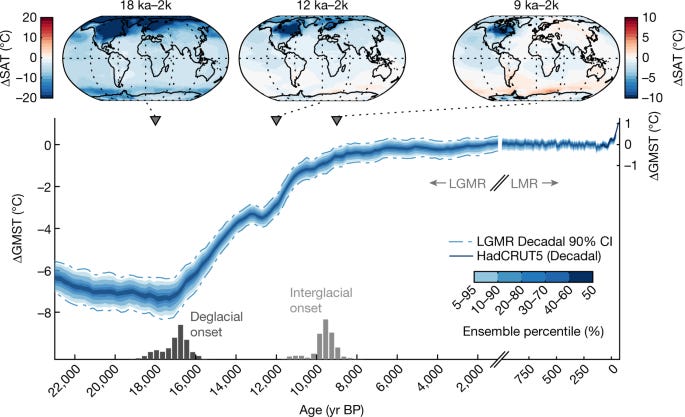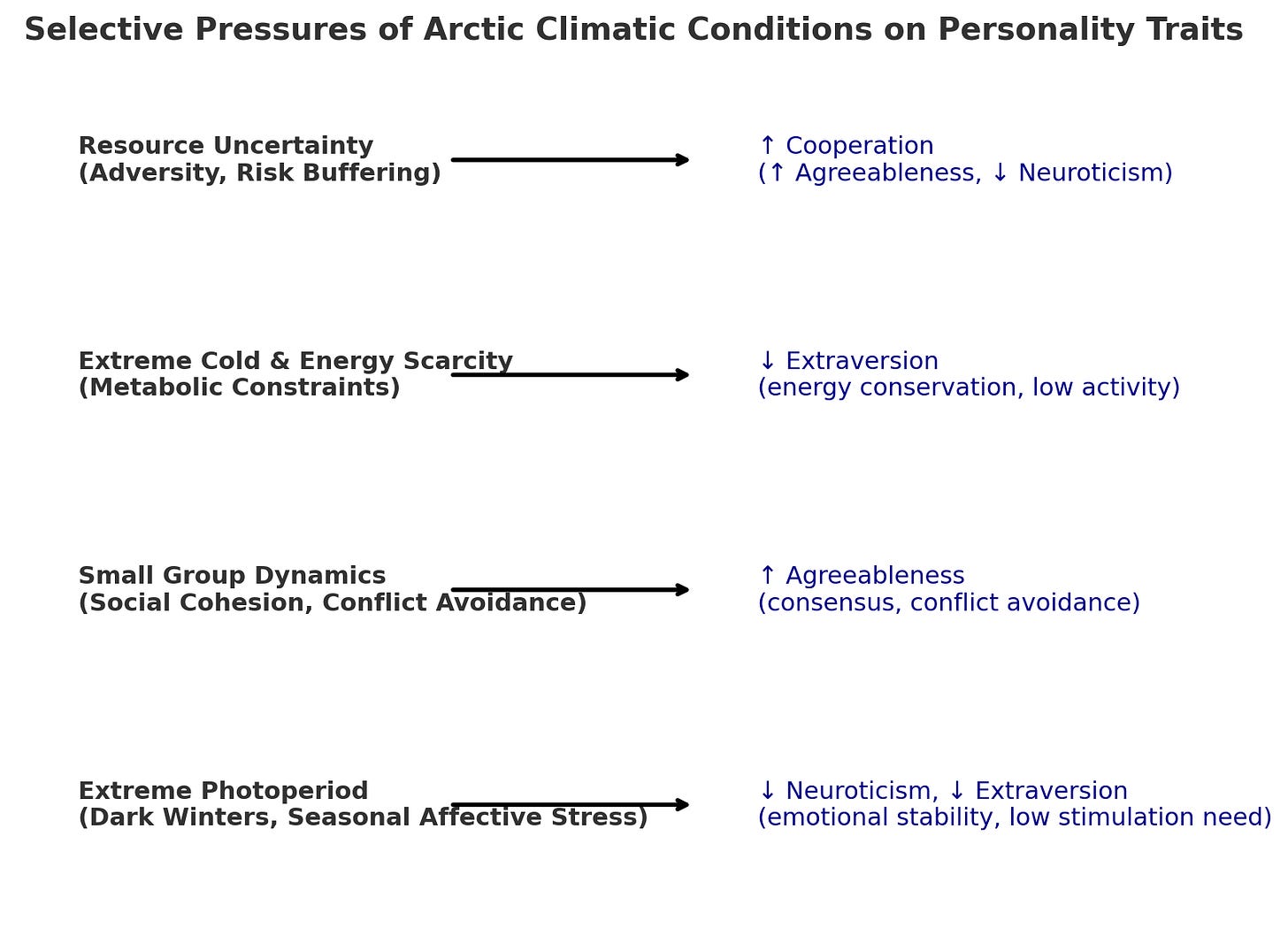Did Harsh Winters Shape Psychology? Answers from Ancient and Modern DNA
There is a long tradition of linking climate to psychological and behavioral variation, from early theories of environmental determinism to more recent cross-cultural studies showing associations between temperature, seasonality, and personality traits. Building on these ideas, an Arctic-origins framework has been proposed by David Sun (2025), suggesting that survival in harsh, highly seasonal ecologies may have shaped patterns of social and emotional functioning over evolutionary time. Although this framework does not make polygenic predictions, it provides a foundation for testable hypotheses. To bring it into dialogue with genetics, I translated the framework into a Big-Five–based operationalization: if these ecologies left a long shadow, we should observe population-level genomic signals consistent (on average) with lower Extraversion and Neuroticism and higher Agreeableness. This translation is my interpretation, intended to generate measurable predictions from ancient and modern DNA. The paper is currently under review, and additional methodological details and references will be available in the forthcoming preprint
Theoretical Framework: Mechanisms and Predictions
Evolutionary Pathway from Arctic Ecology to Personality
The proposed mechanism linking harsh Arctic conditions to personality shifts operates through multiple selective pressures acting over thousands of generations. Here, ‘Arctic’ is used in a broad sense to include not only the Arctic proper but also sub-Arctic regions and other environments characterized by prolonged cold winters. In the analyses, latitude was included as a continuous variable, since it serves as a strong proxy for cold-climate exposure and is mechanistically tied to both UV intensity and photoperiod variation.
Resource Scarcity and Cooperation: Theoretical models from behavioral ecology demonstrate that environmental adversity and uncertainty favor the emergence of cooperation, with mathematical arguments and simulations showing that individuals in more adverse environments perceive resources as more unpredictable, and this unpredictability favors cooperative strategies (Andras, Lazarus, & Roberts, 2007; Ibbotson et al., 2022). While direct archaeological evidence for personality-relevant behaviors is limited, ethnographic studies of circumpolar populations provide compelling support: Inuit communities across Alaska and Canada maintain elaborate food-sharing networks where communities experiencing harvest difficulties receive food from others (Kishigami, 2006; Collings et al., 2016). Research on Canadian Inuit food systems shows that sharing channels country food to individuals who do not hunt and provides households with buffering against climate risks (Ready et al., 2018). Hunting, harvesting, and sharing of country food play an integral role in social cohesion and cultural continuity for Inuit communities, with country food remaining central to Inuit cultural identity (Kishigami, 2006; Ethnology, 2002). These documented patterns of resource sharing, community-wide risk buffering, and conflict-avoidance strategies align closely with behavioral predictions of higher Agreeableness and lower Neuroticism under conditions of resource uncertainty.
Emotional Regulation Under Stress: High Neuroticism - characterized by anxiety, emotional volatility, and stress reactivity - is particularly maladaptive in environments where survival margins are thin. Elevated stress responses in subsistence contexts can undermine decision-making, leading to impulsive resource consumption, loss of focus during extended hunting or food processing, or panic responses in high-stakes situations (Lahey, 2009; Ormel et al., 2013). In contrast, the ecological demands of Arctic life - including tracking seasonal resources, planning for months-long cold periods, and coordinating food-sharing and cooperative labor in confined social settings - would favor emotional stability and low trait anxiety (Kishigami, 2006; Ready et al., 2018). Under such conditions, individuals with lower Neuroticism would have been better equipped to maintain the foresight, planning, and cooperative social functioning essential for survival.
Energy Conservation and Social Dynamics. Lower Extraversion may emerge from the metabolic economics of extreme environments. Extraversion is associated with sensation-seeking, social assertiveness, and elevated activity levels (Costa & McCrae, 1992), traits that can be energetically costly when calories are scarce and subsistence activity must be carefully rationed. In Arctic subsistence contexts, where food acquisition is highly seasonal and energy expenditures are tightly constrained, excessive activity or novelty-seeking would reduce survival margins (Kishigami, 2006). Moreover, the small, tightly knit groups necessitated by Arctic living make aggressive self-promotion disruptive rather than advantageous. Ethnographic accounts indicate that leadership often shifted toward consensus-building and conflict avoidance rather than dominance competition, with cooperation and food sharing serving as central mechanisms for social stability (Collings et al., 2016; Ready et al., 2018).
Seasonal Affective Pressures. The extreme photoperiod variations of high latitudes also create unique selective pressures on behavior and personality. Populations needed to maintain group cohesion and effective functioning through months of near-total darkness, conditions that are strongly associated with mood dysregulation and heightened psychological strain (Rosenthal et al., 1984). Under these circumstances, traits associated with emotional stability and reduced stimulation-seeking - namely, lower baseline anxiety (low Neuroticism) and lower Extraversion - would be adaptive, while maintaining prosocial orientation (high Agreeableness) would help prevent social breakdown during prolonged periods of isolation (Lahey, 2009; Ormel et al., 2013).
Figure 1. Schematic representation of David Sun’s model.
The methods
I built polygenic scores (PGS) for Agreeableness, Extraversion, and Neuroticism from large genome-wide studies. A PGS is one summary number that adds up thousands of tiny DNA effects linked to a trait; each effect is minuscule on its own, but together they sketch extremely faint group-level tendencies. To keep the signal clean, I used conservative quality control, including clumping/thresholding—in practice, keeping one representative variant per genomic neighborhood and dropping weaker, redundant ones.
I utilized the largest and most recent GWAS on the Big Five personality traits from Schwaba et al. (2025), encompassing 46 cohorts with 611,000 to 1.14 million participants of primarily European and African ancestry. These polygenic scores accounted for approximately 9% of the variance in each trait, increasing to 10%–16% after correcting for measurement unreliability. Importantly, genetic influences on personality showed high consistency across geographic regions, raters (self vs. close others), age groups, and assessment methods, though Agreeableness demonstrated lower consistency across geography and rating instruments. A critical validation was that polygenic scores maintained predictive validity in within-family analyses, suggesting minimal confounding by shared environmental factors and supporting genuine genetic effects rather than population stratification artifacts.
I applied these scores to modern genomes from many populations and to ancient genomes spanning the Late Pleistocene into the Holocene. In Western Eurasia, I modeled how scores change through time with a hinge regression and placed two knots where climate history gives us compelling breakpoints: a strict one at the end of the LGM (19,000 years ago) and a second at the beginning of the Holocene (12,000 years ago). I’ll include the plots in the post; the first knot anchors the deglacial onset, and the second captures the transition to truly interglacial conditions. The 19 kya choice follows the canonical timing of LGM termination in global ice extent, while the 12 kya knot aligns with the Holocene start at ~11.7 kya after the Younger Dryas cold reversal (Fig. 2).
Why that second knot at 12 kya?
• The LGM was globally ~6.1 °C colder than preindustrial; ice-sheet retreat from LGM maxima spans 26.5–19/20 kya, so 19 kya is a defensible “strict” deglacial hinge (Tierney et al., 2020).
• From 20→10 kya, the mean global ocean warmed ~2.57 ± 0.24 °C, i.e., only part of the LGM→Holocene contrast had been made up by 12 kya (Bereiter et al., 2018).
• The deglaciation was stepwise: a Northern-Hemisphere Bølling–Allerød warm pulse 14.7–12.9 kya, followed by the Younger Dryas cold reversal 12.9–11.7 kya; the abrupt shift to sustained interglacial warmth occurs at ~11.7 kya—the Holocene start (He et al., 2021).
Together, these data support treating 12 kya as a second hinge: by then conditions were less cold than LGM, but not yet stably warm until the Holocene begins (Osman et al, 2021).
Figure 2.

In Eastern Eurasia, pre-Holocene coverage is thinner, so instead of forcing a time trend I tested how specific ancestry components (e.g., Arctic/Siberian, Jōmon, Tibetan, Northeast Chinese) relate to the same scores within the Holocene, alongside geography. Finally, for the modern snapshot, I checked whether the three traits move together on a single axis—useful as a compact “personality factor” to compare across places and times.
The results
Western Eurasia: a Late-Pleistocene → Holocene pivot
At the population level, correlations among mean polygenic scores for the three traits were modest (Extraversion–Neuroticism: r = 0.27; Agreeableness–Neuroticism: r = −0.19; Extraversion–Agreeableness: r = −0.03). Tests of factorability were mixed: the KMO statistic was borderline (0.503), but Bartlett’s test supported proceeding (χ²(3) = 10.50, p = 0.015). Parallel analysis indicated a single latent dimension. A one-factor solution, extracted via principal-axis factoring, yielded a weak but coherent factor dominated by Neuroticism, with smaller, opposing loadings of Extraversion and Agreeableness. For interpretability, factor scores were oriented such that higher values reflect greater Agreeableness and emotional stability (i.e., low Neuroticism and Extraversion).
Approaching the LGM, genetics linked to lower Extraversion and lower Neuroticism strengthen, with higher Agreeableness moving in the complementary direction. After the Ice Age, those trends ease or reverse. The bend captured by the two-knot model fits a picture of selection tightening in the cold and relaxing in the warmer Holocene (Fig. 3).



